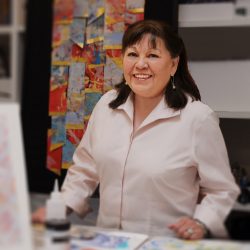In Ramona Sakiestewa’s new tapestry series she refers to her pieces as nebulae, but this work seems more earthy to me. Instead of looking up and off into distant spaces, I feel like I’m looking down at landcapes color coded the way Landsat mapping systems appear. It is as if Sakiestewa has been taking readings of the planet’s continental geography by way of remote sensing devices, following the contours of land and oceans, or the configurations of escarpments, ridges, mesas, or mountains. But to call this work earthy does not limit the effects of these intensely vibrant tapestries, where color is above all pulsating. This work exists at the interface of textiles and abstract painting, and the addition of texture deepens the experience of Sakiestewa’s palette.
Perhaps the most “nebulous” of all these tapestries, and the one I liked the best, was Nebula 11B, hung in the office and seen through a doorway. The distance between the viewer and the work itself was advantageous and enhanced the perception of the subtle gradations of color. This work is the most nuanced of the series – the least eye-grabbing but the most luminous. The red/red orange/orange/pink/violet/violet pink appeared as if the tapestry were a face blushing in all directions. You couldn’t quite say where one color began or ended; there were no clear boundaries in the abstract shapes depicted. It looked like two waves rolling, as opposed to crashing, into one another. And it made for a soft collision, a sensual chromatic absorption of forms and, in this case, a luscious bleeding of hues very much akin to those distant clouds of interstellar dust and gas.
Turning away from the dreamy state induced by Nebula 11B, the viewer was struck anew by Sakiestewa’s use of red—as if she had single handedly invented that color as her own representation of the life force that fuels her passion for creating and her multiple roles in the art world. Sakiestewa is protean in her visions of art as a direct evolution of techniques grounded in her Native American roots and yet she is freewheeling in her interests, which encompass astrophysics, urban environments, the history of abstract painting, and the quest to identify with the grandness of the cosmos. These new tapestries offer a breadth of vision that embraces not only the reality of stellar formation but also the universality of our own bodies, each one with its own driving pulse. This is something we all share, something that serves to unite us rather than divide us—blood, pulse, passion.

